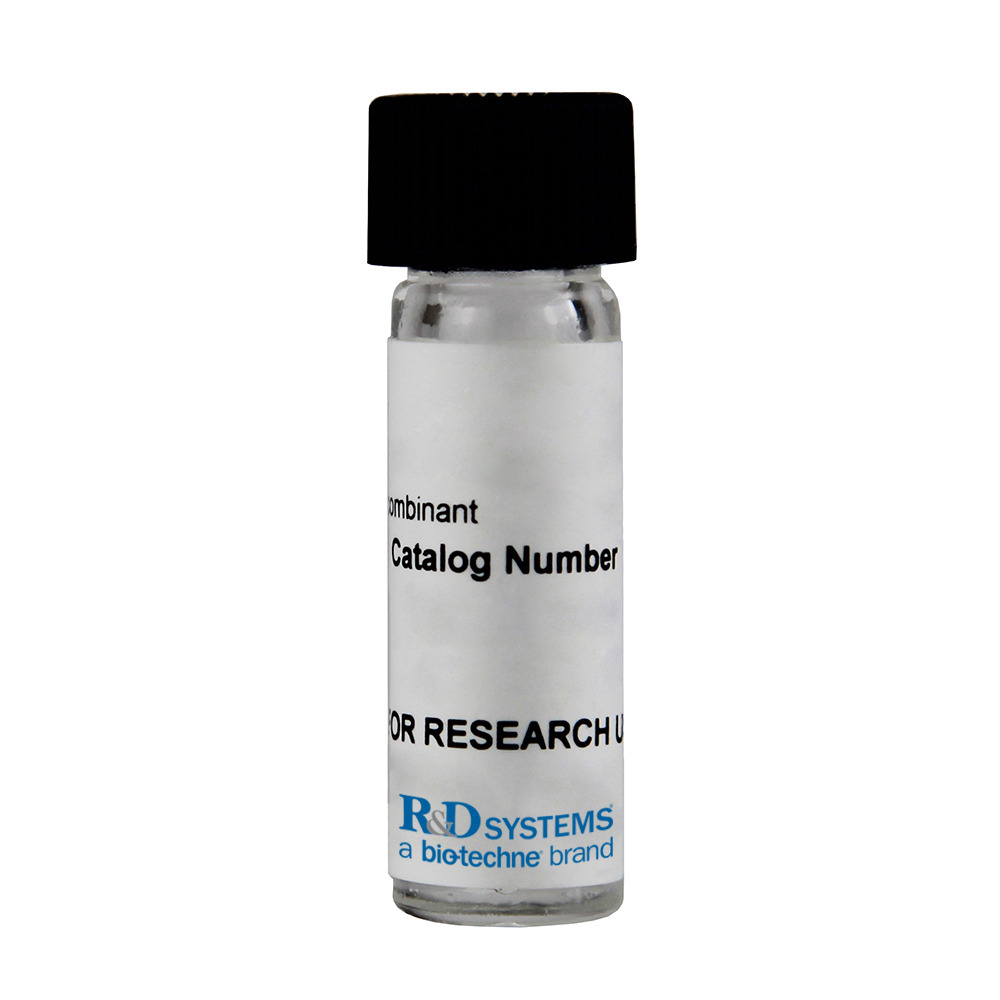Recombinant Mouse Artemin Protein
R&D Systems, part of Bio-Techne | Catalog # 1085-AR

Key Product Details
- R&D Systems E. coli-derived Recombinant Mouse Artemin Protein (1085-AR)
- Quality control testing to verify active proteins with lot specific assays by in-house scientists
- All R&D Systems proteins are covered with a 100% guarantee
Source
Accession #
Structure / Form
Conjugate
Applications
Product Specifications
Source
Ala112-Gly224
Purity
Endotoxin Level
N-terminal Sequence Analysis
Predicted Molecular Mass
Activity
The ED50 for this effect is 2-8 ng/mL.
Measured by its binding ability in a functional ELISA.
Immobilized Recombinant Mouse GFR alpha‑3/GDNF R alpha‑3 Fc Chimera (Catalog # 2645-FR) at 1 µg/mL (100 µL/well) can bind Recombinant Mouse Artemin with an apparent KD <1 nM.
Formulation, Preparation and Storage
Carrier Free
What does CF mean?CF stands for Carrier Free (CF). We typically add Bovine Serum Albumin (BSA) as a carrier protein to our recombinant proteins. Adding a carrier protein enhances protein stability, increases shelf-life, and allows the recombinant protein to be stored at a more dilute concentration. The carrier free version does not contain BSA.
What formulation is right for me?In general, we advise purchasing the recombinant protein with BSA for use in cell or tissue culture, or as an ELISA standard. In contrast, the carrier free protein is recommended for applications, in which the presence of BSA could interfere.
Carrier: 1085-AR
| Formulation | Lyophilized from a 0.2 μm filtered solution in Acetonitrile and TFA with BSA as a carrier protein. |
| Reconstitution | Reconstitute at 100 μg/mL in sterile 4 mM HCI containing at least 0.1% human or bovine serum albumin. |
| Shipping | The product is shipped at ambient temperature. Upon receipt, store it immediately at the temperature recommended below. |
| Stability & Storage | Use a manual defrost freezer and avoid repeated freeze-thaw cycles.
|
Carrier Free: 1085-AR/CF
| Formulation | Lyophilized from a 0.2 μm filtered solution in Acetonitrile and TFA. |
| Reconstitution | Reconstitute at 100 μg/mL in sterile 4 mM HCl. |
| Shipping | The product is shipped at ambient temperature. Upon receipt, store it immediately at the temperature recommended below. |
| Stability & Storage | Use a manual defrost freezer and avoid repeated freeze-thaw cycles.
|
Background: Artemin
Artemin is a member of the Glia Cell-Derived Neurotrophic factor (GDNF) family ligands, which include GDNF, Persephin, Artemin, and Neurturin. GDNF family ligands are distant members of the Transforming Growth Factor beta (TGF-beta) superfamily (1-4). Similar to other TGF-beta family proteins, Artemin is synthesized as a large precursor protein that is cleaved at the dibasic cleavage site (RXXR) to release the carboxy-terminal domain. The carboxy-terminal domain of Artemin contains the characteristic seven conserved cysteine residues necessary for the formation of the cysteine-knot and the single interchain disulfide bond. Biologically active Artemin is a disulfide-linked homodimer of the carboxy-terminal 113 amino acid residues. Mature mouse Artemin shares 88.5% amino acid sequence similarity with human Artemin. Mature Artemin also shares approximately 40% amino acid sequence identity with the other three members of the GDNF family ligands (5). Bioactivities of all GDNF family ligands are mediated through a receptor complex composed of a high affinity ligand binding component (GFR alpha-1-GFR alpha-4) and a common signaling component, cRET (receptor tyrosine kinase) (5-8). Artemin prefers to bind to GFR alpha-3 and activites the GFR alpha-3-RET. However, in the presence of RET, it can bind to GFR alpha-1 as well (4, 5, 9). Artemin has been shown to promote the survival and growth of various peripheral and central neurons, including sympathetic and dopaminergic neurons. It may also play an important role in the development of sympathetic neurons and several organs (5, 10, 11).
References
- Lin, L-F.H. et al. (1993) Science 260:1130.
- Milbrandt, J. et al. (1998) Neuron 20:245.
- Kotzbauer, P.T. et al. (1996) Nature 384:467.
- Baloh, R.H. et al. (1998) Neuron 21:1291.
- Takahashi, M. (2001) Cytokine and Growth Factor Reviews 12:361.
- Baloh, R.H. et al. (1997) Neuron 18:793.
- Jing, S. et al. (1996) Cell 85:1113.
- Jing, S. et al. (1997) J Biol Chem 272:33111.
- Nishino, J. et al. (1999) Neuron 23:725.
- Enomoto, H. et al. (2001) Development 128:3963.
- Andres, R. et al. (2001) Development 128:3685.
Alternate Names
Gene Symbol
UniProt
Additional Artemin Products
Product Documents for Recombinant Mouse Artemin Protein
Product Specific Notices for Recombinant Mouse Artemin Protein
For research use only
